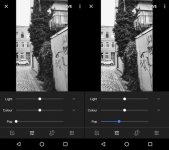Couple things. Firstly, where did I say "types of information"? I effectively agreed with your characterization of "type of information" and we also agreed that light is a medium. What I am saying as that the informaiton being carried by the light is possibly being lost in high element count lenses where the aperture value is greater by than the t-stop value (such as the Sigma Art), and the additive effect of the loss of "this information" (not "new type of information") COULD BE causing a loss of perceived dimensionality in the image. Secondly, I never said that what I floated was "fact", I suggested it as a "possibility" and was careful with my word choice and reiterated this as "possiblity" on several subsequent posts. Therefore, no "tin foil hat" as nothing was stated as irrefutable fact. "UFOs HAVE landed" -- tin foul hat. "There is ample evidence, seems to me, to leave open the possibility of UFO visitation" -- no tin foil hat. And thanks for the unnecessary line about critical thinking skills. Not necessary, mind you, but the it's always nice to reinforce them.
And, really, what fun would the internet and blogs like this be without its malaperts?
Okay. You said that “tonality” was a type of information carried by light, that was somehow lost when the transmission and f-stop were different. It’s not even a possibility, it’s flat out 100% incorrect.
Your thesis is that when the transmission of a lens is reduced the optical properties drop - we lose tonality. Again, there is not even the slightest chance that this might be even the tiniest bit of a possibility. If your thesis is correct, then every lens shot wide open would have higher contrast and better tonality than the same lens at f/5.6. We know this is totally untrue from MTF curves (which measure contrast and resolution, and therefore tonality), and from experience.
In short, your possibility is not even that, it is merely a rambling presented as a possible truth.
As to your last sentence, spreading misinformation like it is true only serves to dumb down the population. Without it the internet might actually be useful.
The only things you presented that are of value are;
1) Lenses with fewer elements are pleasing to you and many others
2) Modern highly corrected lenses are less pleasing
3) In some modern highly corrected lens the T-stop and F-stop are not the same value. (I would love to see the T-stop of some of the uncoated lenses with 3-4 lenses - I bet that they’re nowhere near the F-stop).
Like I said in my previous post, correlation does not imply causation. But, it would be interesting to explore the points I summarized above in a more scientific or logical way.



